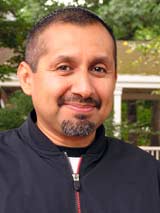 EUGENE,
EUGENE,
Ore. -- (June 22, 2009) -- Becoming
literate can be more than twice the challenge for children of two cultures,
said Edward M. Olivos, a University of Oregon expert in biliteracy education.
"Providing
instruction that fosters mastery in academic subjects for the English learner
can be a challenge for schools as well," said Olivos, UO assistant professor of
teacher education."Creating equitable learning for language minority
children means meeting the rapidly growing need for quality bilingual teachers."
That's
no small order in Oregon, where, in the last
15 years, the percentage of English learners (EL) in Oregon public schools has grown by 163
percent, to nearly 68,000 students.
To
examine the best ways for districts to meet the needs of these students, Olivos
and the UO College of Education will host "New Destinations," the
2009 University of Oregon Conference on Biliteracy June 25-27 in Eugene. The conference
brings together more than 200 educators to interact with 60 experts in
biliteracy education. Public educators, administrators, parents and community
members will meet with scholars and policy makers to learn more about the best
methods research recommends for meeting the needs of the growing population of
English learners in Oregon
schools.
Olivos
is the author of "The Power of Parents: A Critical Perspective of
Bicultural Parent Involvement in Public Schools." He organized the conference to highlight the emergence of Oregon and other areas in the Northwest as the new
destination points for families migrating from international points of origin,
and from other states, including California
and Texas.
"This
is a critical point in the development of our educational system," said Olivos,
who notes that Oregon benefits from being able to examine the successful - and
less successful - approaches taken in other states to meet the increasing
diversity in public schools.
Fifteen
years ago, Latino students were 6.8 percent of Oregon's
school population. Currently, they represent nearly 17 percent of the student
population.
"At
the current growth rate, the Oregon Department of Education projects that 28
percent of student enrollment in the state will be Latino by 2020," says
Olivos. "As educators, we must look at how to best serve all students and
provide the best access and opportunity."
For
more information about the "New Destinations" conference, including
registration, visit http://biliteracy09.uoregon.edu.
Keynote
speakers for the conference include:
-
James Crawford, former Washington editor of
Education Week, past-president of the National Association for Bilingual
Education (NABE), and specialist in the politics of language. -
Kathryn
Lindholm-Leary, professor of Child and Adolescent Development at San Jose State
University, expert in two-way immersion and other bilingual programs for the
past 25 years whose research was used in establishing Title VII funding and
program priorities for two-way immersion programs. -
Jill
Kerper Mora, associate professor of Teacher Education at San
Diego State University, analyst of legal and policy issues that
affect the education of language minority and immigrant students, including
Proposition 227 in California.